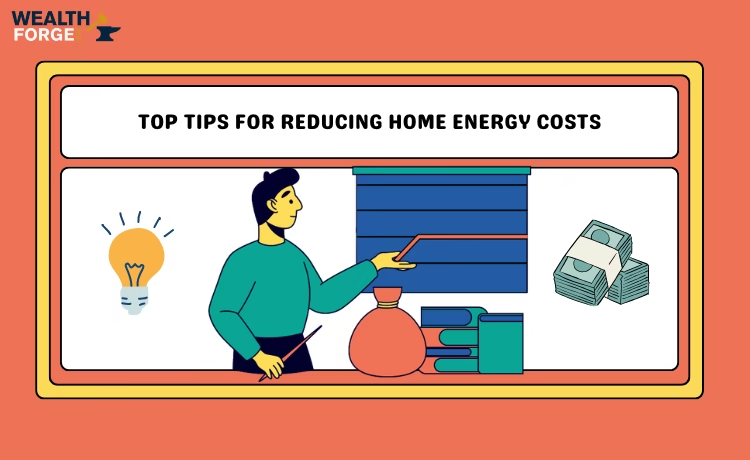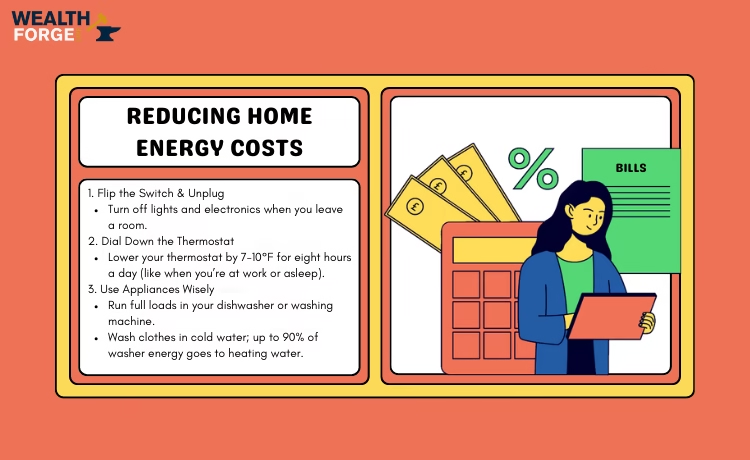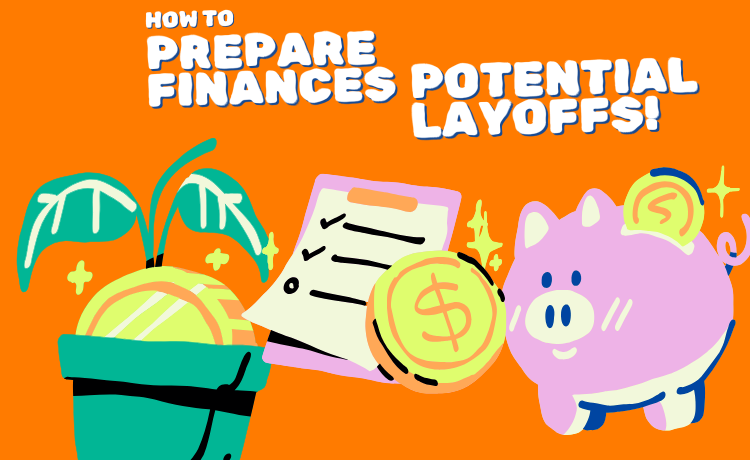Reducing your utility bills doesn’t just save you money – it gives the planet a break, too! If you’ve felt that monthly sting from energy, water, or gas bills, it’s time for a change.
Get ready for actionable strategies to cut your costs, shrink your carbon footprint, and make your home a model of eco-smart living.
Whether you own or rent, these tried-and-true tips will help you become a master of your savings—starting today!
What we have cover!
- 1 Why Lowering Utility Bills Matters
- 2 Where Does Your Energy Go? Break Down Your Home’s Biggest Power Hogs
- 3 Quick and Easy Tips for Immediate Savings
- 4 Smart Home Upgrades That Pay for Themselves
- 5 DIY Energy Audits: Find (and Fix!) Hidden Energy Wasters
- 6 Don’t Miss Out! Tap Into Government Incentives and Rebates
- 7 Case Studies: Real Savings, Real Stories
- 8 Frequently Asked Questions
- 9 Take Charge and Start Saving Today!
Why Lowering Utility Bills Matters

Every penny you save on your energy bills is a win for your wallet and the world! Utility costs are on the rise, and residential energy consumption accounts for about 20% of greenhouse gas emissions in the U.S., according to the EPA (source). Reducing your home’s energy demand not only protects your finances but also supports a cleaner, healthier environment for everyone.
This guide will show you:
- How to spot the biggest energy drains in your home
- Simple habits that yield instant savings
- High-impact upgrades that pay off fast
- How to sniff out hidden leaks with your energy audit
- Which government incentives can put money right back in your pocket
- Inspiring stories from real people like you who made it work
Where Does Your Energy Go? Break Down Your Home’s Biggest Power Hogs
Before you can take control, you need to know what’s draining your energy! According to the U.S. Energy Information Administration (EIA), these are the main culprits:
- Heating and Cooling: 45-50% of average home energy use
- Water Heating: 18%
- Appliances: 13%
- Lighting: 9%
- Electronics & Miscellaneous: 10%
Quick check: If your bills feel high, it’s usually your climate control (AC and furnace) or water heater doing the heavy lifting!
Quick and Easy Tips for Immediate Savings

You don’t need a huge budget to start saving! These simple changes can deliver results by your next bill:
1. Flip the Switch & Unplug
- Turn off lights and electronics when you leave a room.
- Unplug phone chargers, coffee makers, and game consoles when not in use. Many devices draw “phantom” power even when off!
- Consider using smart power strips for electronics to cut power automatically.
2. Dial Down the Thermostat
- Lower your thermostat by 7-10°F for eight hours a day (like when you’re at work or asleep).
- According to the Department of Energy, this can save up to 10% a year on heating and cooling! (DOE source)
- Wear an extra layer in winter and use a fan instead of cranking the AC in summer.
3. Use Appliances Wisely
- Run full loads in your dishwasher or washing machine.
- Wash clothes in cold water; up to 90% of washer energy goes to heating water.
- Air-dry clothes and dishes when possible.
4. Switch to LED Lighting
- Swap all your bulbs for LEDs. They use up to 85% less energy and last 25x longer than incandescent bulbs (EnergyStar).
5. Take Shorter Showers
- Heating water is expensive! Cutting your shower by just a few minutes saves significant energy and water.
6. Fix Water Leaks
- A dripping faucet wastes up to 3,000 gallons a year (EPA WaterSense), and every drop is money down the drain.
Pro tip: Invite your family or roommates to a “utility challenge.” See who can save the most kilowatt-hours or gallons in a month—with a prize for the winner!
Learn about The Best Free Budgeting Tools and Apps
Smart Home Upgrades That Pay for Themselves
If you have a little more to invest, these upgrades can deliver big long-term returns:
1. Energy-Efficient Appliances
- Choose ENERGY STAR®-rated appliances whenever possible.
- According to the EPA, an ENERGY STAR refrigerator can save over $300 on utility bills during its lifetime (EPA ENERGY STAR).
2. Programmable & Smart Thermostats
- A smart thermostat learns your schedule and makes automatic adjustments for maximum savings. The Nest Thermostat, for example, reports average annual savings of $131-$145 (Nest impact).
3. Water-Saving Fixtures
- Install low-flow showerheads and faucet aerators. These simple updates can cut your water heating bills and reduce water usage by up to 60%.
4. Insulation & Sealing
- Insulate attics, walls, and floors if possible.
- Seal windows and doors with weatherstripping to prevent drafts. The Department of Energy estimates you could save up to 20% on heating and cooling by properly sealing and insulating your home (DOE insulation guide).
5. Solar Panels
- If you own your home and have roof space, solar is making more sense (and cents) than ever. Many states offer generous rebates, tax credits, and net metering policies.
DIY Energy Audits: Find (and Fix!) Hidden Energy Wasters
Don’t wait for a pro! Conducting a simple home energy audit can reveal some huge savings opportunities.
How to Do a Basic Home Audit
- Check Doors and Windows: Feel for drafts or look for gaps where air can escape.
- Look for Poor Insulation: Are your walls, attic, or floors cold in winter or hot in summer? Time to check the insulation.
- Test Faucets and Pipes: Inspect for leaks both indoors and outdoors.
- Review Appliance Settings: Make sure refrigerators are set between 37–40°F and water heaters around 120°F.
- Inventory Electronics: Identify devices left plugged in all day.
For more guidance, check out the U.S. Department of Energy’s DIY energy audit checklist.
Don’t Miss Out! Tap Into Government Incentives and Rebates
Many federal, state, and local governments offer exceptional incentives that make upgrading your home more affordable!
- Federal Tax Credits: The U.S. offers credits for new windows, insulation, HVAC, and solar systems. Check the ENERGY STAR Rebate Finder.
- Utility Rebates: Local utility companies often offer rebates for efficient appliances or home energy audits.
- State Initiatives: Programs like California’s Energy Upgrade California and New York’s Home Performance with ENERGY STAR provide cash-back offers and low-cost loans.
Pro tip: Stack your savings! Combine manufacturer promotions, utility rebates, and government credits to maximize your benefits.
Must read The Top Benefits of Filing Your Taxes Early
Case Studies: Real Savings, Real Stories
Nothing’s more convincing than real-life results! Here are a few inspiring stories you can learn from:
The Martinez Family’s $900 Annual Savings
The Martinezes, a family of five from Austin, Texas, transformed their drafty house with new insulation, LED lighting, and a programmable thermostat. They also replaced their aging fridge with an ENERGY STAR model. Their utility bills dropped by more than $75 per month. “It paid for itself within two years! Now, every month is another win.” – Claudia Martinez.
Solo Renter’s Success with Smart Plugs
Maya, a New York City renter, used smart plugs and a simple window draft stopper kit to cut her electric bill by 20%. She shares, “I couldn’t believe such small gadgets would make such a big difference!“
Solar-Powered Suburbia
Jake and Nia in Arizona installed solar panels with help from SunPower and leveraged state and federal tax credits. Their panels now cover 90% of their annual electricity needs, and their net bills during summer heatwaves are often less than $30.
Frequently Asked Questions
Q1. Will these energy-saving tips work if I rent, not own?
Absolutely! Many strategies, especially behavioral changes and simple upgrades (like LEDs, draft stoppers, and smart plugs) work great for renters. Bigger investments, like new insulation or solar, usually require landlord approval.
Q2. Do smart thermostats make a difference?
Yes! According to Nest’s data, most users save 10–12% on heating and 15% on cooling bills after installing a smart thermostat.
Q3. How soon can I see savings?
Some shifts, like unplugging devices or switching to LEDs, reduce your next bill. Larger upgrades (e.g., insulation) take months or up to a couple of years to pay back.
Q4. Where can I find personalized help?
Many utility companies offer free or discounted professional energy audits. Check your electricity provider’s website or contact your local government’s sustainability office.
Q5. How do I get my landlord on board with upgrades?
Share the numbers! Show how improving efficiency adds value, reduces maintenance, and can boost property appeal for future tenants. Back your pitch with free resources from Energy Star’s Landlord Guide.
Take Charge and Start Saving Today!
Slashing your utility bills isn’t just about saving money (though it feels fantastic!). It’s about making your home more comfortable, sustainable, and resilient. Whether you live alone or with a busy family, you have the power to create meaningful change, starting one small step at a time.
Try a free DIY audit this weekend. Pick a few easy tips from this guide, and set a calendar reminder to check your savings at the end of the month. If you’re ready for upgrades, explore rebates and make one investment at a time.
Every kilowatt-hour and drop of water you conserve has real, lasting value. Happy saving, eco-champions!

